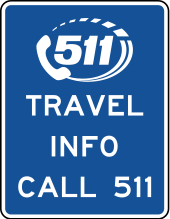N11 code
An N11 code (pronounced Enn-one-one) is a three-digit telephone number used in abbreviated dialing in some telephone administrations of the North American Numbering Plan (NANP).

Services
N11-numbers are used to access to special services. For example,

- 2-1-1: Community services and information
- 3-1-1: Municipal government services, non-emergency number
- 4-1-1: Directory assistance
- 5-1-1: Traffic information or police non-emergency services
- 6-1-1: Telephone company (telco) customer service and repair
- 7-1-1: TDD and Relay Services for the deaf and hard of hearing
- 8-1-1: Underground public utility location (United States);[1] non-emergency health information and services (Canada)
- 9-1-1: Emergency services (police, fire, ambulance and rescue services)
(4-1-1 and 6-1-1 are commonly used within the United States, but not officially assigned by the Federal Communications Commission.)
In addition, 9-8-8 is currently being in the process of being adopted as the number for the National Suicide Prevention Hotline. The change will fully go into effect on July 16, 2022.
The designation for special use in the NANP prevents their use as area code or central office prefix, eliminating nearly 8,000,000 telephone numbers from assignment.
The assigned use of each N11 can vary for the various countries included in the NANP, but 9-1-1 is mandated in the United States and Canada, while the availability of the other N11 codes varies by location. 7-1-1 and 9-1-1 access is mandated by law in the United States, even within private networks (PBX, enterprise and cellular systems).
4-1-1 and 6-1-1 are supported by the service provider for the calling phone, but not all carriers provide these services. 4-1-1 and 6-1-1 (formerly 8-1-1) are typically blocked within enterprise or private branch exchange (PBX) systems, including cellular telephone service purchased for an enterprise system, since 4-1-1 calls generally incur a fee and the service is now readily accessible by other means, and 6-1-1 services are managed by the enterprise in which the phone resides.
Other community services are provided through 2-1-1, but only if a nonprofit organization, such as United Way of America, or the local government operates it locally. Likewise, local, state or provincial government may, but do not uniformly, operate traffic information using 5-1-1. 8-1-1 was made mandatory in the United States in 2007; however, it has not been universally implemented. 7-1-1 is funded through the TRS Fund, which telephone companies are mandated to maintain to provide Relay Services for the Deaf and Hearing Impaired.
0-1-1 and 1-1-1
Within the NANP, a leading digit of 0 or 1 indicates special dialing arrangements. For example, 0-1-1 followed by a country code is used to dial internationally or 1 followed by a ten-digit phone number indicating long distance or toll charges. In a few states, some areas retain the ability to use seven-digit dialing for local calls; in these areas a leading digit of 1- must be followed by a ten-digit phone number. As such, N11s are restricted by NANP design to N values 2 through 9, creating the eight allowable N11s. This is also why NPAs (area codes) or seven-digit phone numbers (designated by NXX-XXXX) cannot have a 0 or 1 as the first digit (N).
See also
References
- See Federal Communications Commission Document No. 92-105
External links
- FAQ on Use of N11 Service Codes
- N11 Codes Assignment from NANPA.com
- Administered N11 Codes in Canada